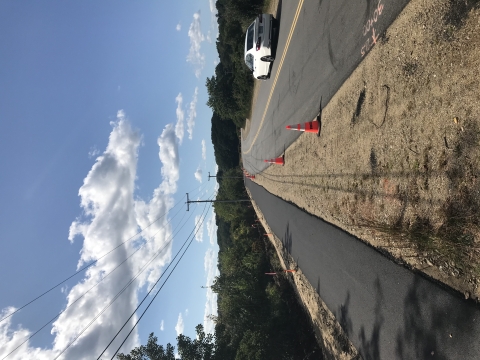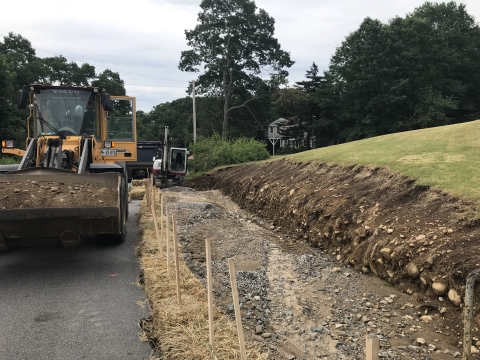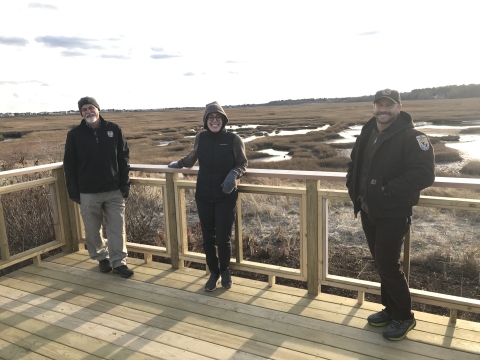Residents of Wells, Maine, are now enjoying the beauty of a recently finished nature trail that passes through Rachel Carson National Wildlife Refuge.
The mile-long pedestrian trail, supported by funding from a Federal Lands Access Program (FLAP) grant, starts east of U.S. Route 1 in downtown Wells, Maine, and proceeds through a residential neighborhood before continuing along Harbor Road on one side and the refuge-managed Webhannet River Salt Marsh on the other. The trail links downtown Wells to Wells Harbor and a popular beach area, as well as an existing trail network created by the town and the Wells National Estuarine Research Reserve.
Refuge staff worked with the town and Wright Pierce Engineering to design the project in such a way that pedestrian access, public safety, resource conservation, and wildlife observation opportunities were maximized at the Lower Wells Division of the Rachel Carson National Wildlife Refuge. Construction of the trail was implemented by Foglio, a Waterboro, Maine-based construction firm.
Prior to the trail’s construction, pedestrian access to this area of the refuge was limited, apart from walking alongside the heavily trafficked road without a guardrail.
Now, residents will have a safe and eco-friendly alternative for traveling along Harbor Road and improved opportunities for plant and wildlife viewing within the Refuge. Interpretative signage installed along the trail provides walkers a chance to learn more about the ecology within the refuge. Also included on the path is a newly constructed observation deck of the marsh.
“We at the refuge are excited about the new pedestrian trail at Harbor Road in Wells,” says Karl Stromayer, Refuge Manager at the Rachel Carson National Wildlife Refuge. “It's going to be a huge asset in helping us connect people to nature and helps meet the Town's objectives for active transit and reducing traffic volume on town roads during the busy spring and summer (vacation) seasons.”
This trail complements other planned improvements under the town’s Updated Harbor Management Plan. The plan is aimed at designing and constructing sidewalks, bike lanes, streetscape improvements, and providing pedestrian amenities along Harbor Road and within Harbor Park, while minimizing the need to widen impervious surfaces and the existing roadway.
The Federal Lands Access Program (FLAP) was established by the Federal Highway Administration to improve transportation facilities that provide access to, are adjacent to, or are located within U.S. Federal lands. FLAP grants benefit the U.S. Fish and Wildlife Service by improving access to facilities through constructing or repaving roads, multi-purpose trails, bicycle paths, and boat ramps. The Program can also be used to purchase buses, trams, bicycles, and kayaks for people to access public lands.
Another recent FLAP grant project led by the U.S. Fish and Wildlife Service’s North Atlantic- Appalachian Region took place in Virginia. The grant allowed the Service to construct barriers along the eastern end of the Chesapeake Bay Bridge Tunnel exit road to protect terrapins from migrating across the road at the Eastern Shore of Virginia National Wildlife Refuge.
The Harbor Road pedestrian trail was completed with 20% funds from the Wells community and 80% from FLAP. With the recently passed Bipartisan Infrastructure Law Bipartisan Infrastructure Law
The Bipartisan Infrastructure Law (BIL) is a once-in-a-generation investment in the nation’s infrastructure and economic competitiveness. We were directly appropriated $455 million over five years in BIL funds for programs related to the President’s America the Beautiful initiative.
Learn more about Bipartisan Infrastructure Law , the FLAP will now be able to provide up to 100% of funding for projects – an advantage for communities unable to provide the 20% match originally required by the Program. Additionally, many states in the North Atlantic-Appalachian Region are set to become eligible for FLAP in Fiscal Year 2022. For these reasons, the Service is optimistic that the Program will continue to provide safe access for communities to connect to natural places.






